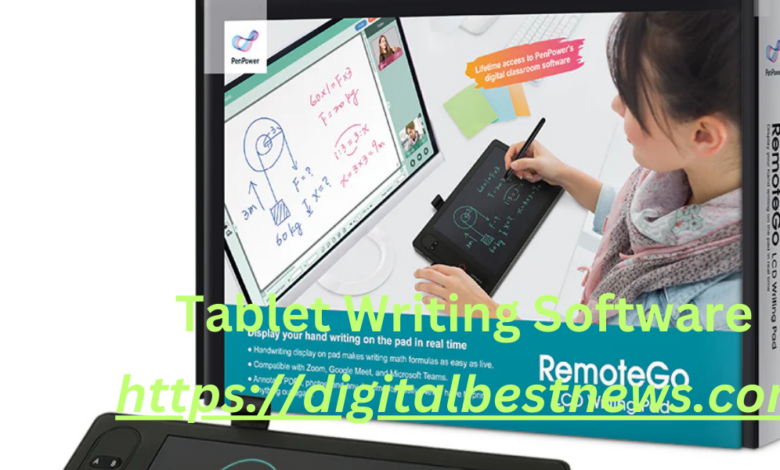Tablet Writing Software: Top Tools for Efficient Digital Writing

In today’s fast-paced Tablet Writing Software, digital note-taking has revolutionized how we capture and organize our thoughts. One of the most innovative tools contributing to this change is tablet writing. Tablet writing merges the convenience of digital technology with the personal touch of handwritten notes, offering a unique way to take, edit, and share information. This guide will explore the world of tablet writing, its tools, benefits, and how it can be an invaluable asset for students, professionals, and creatives alike.
I. Introduction Tablet Writing Software: Unlocking the Potential of Tablet Writing
What is Tablet Writing?
Tablet writing refers to the practice of using digital tablets and stylus pens to write, draw, or annotate content. Unlike traditional paper-based note-taking, tablet writing allows for easy editing, cloud storage, and integration with various productivity tools. With the advent of advanced touchscreen technology and specialized apps, digital tablets have become a powerful alternative to conventional notebooks and pens. The tablet writing experience combines the tactile pleasure of writing with the modern advantages of digital convenience.
The practice of tablet writing has become particularly popular among students, professionals, and creatives who need a versatile and portable solution for capturing ideas on the go. Whether taking lecture notes, signing digital documents, or sketching designs, tablet writing offers a seamless solution for almost any task that once required pen and paper.
Why Tablet Writing is Gaining Popularity
Tablet writing has experienced a significant rise in popularity for several reasons. One key advantage is its ability to combine the benefits of handwriting with the advantages of digital technology. Handwritten notes are often considered superior for memory retention and understanding. However, digital note-taking allows for the organization, searchability, and editing that handwritten notes simply cannot provide Tablet Writing Software.
In addition, tablets and stylus pens offer features such as cloud storage and synchronization across multiple devices, ensuring that your notes are always accessible, whether on your phone, Tablet Writing Software, or computer. This convenience has made tablet writing a preferred choice for students who want to keep all their course materials organized or professionals who need to annotate presentations and documents.
II. Tablet Writing Software Writing Technology: The Tools and Devices Behind the Art
Best Tablets for Writing
Choosing the right tablet for writing is crucial to maximizing the tablet writing experience. There are several options available, Tablet Writing Software offering unique features tailored to different user needs.
Apple’s iPad is widely regarded as one of the best tablets for writing, thanks to its seamless integration with the Apple Pencil, a stylus that provides a natural writing experience. The iPad Pro, in particular, offers a large screen size, making it ideal for detailed note-taking and artistic work. However, the iPad can be on the expensive side, and its operating system may not be suitable for everyone.
For Windows users, the Microsoft Surface Pro is another excellent option. It functions as both a tablet and a laptop, offering the flexibility of a full desktop environment while maintaining portability. The Surface Pen allows for smooth and responsive writing, and with the Microsoft ecosystem, Surface Pro is a fantastic choice for professionals who need to access and modify documents while on the go.
Wacom tablets, especially their Intuos series, are also favored by artists and designers for their precision and high-quality stylus pens. These tablets are designed specifically for creative work, with features that cater to drawing, sketching, and digital painting Tablet Writing Software.
Stylus Pen Comparison: Finding the Perfect Match
A good stylus is just as important as the tablet itself when it comes to tablet writing. Different pens offer varying levels of pressure sensitivity, precision, and ergonomic design, which can significantly affect the writing experience Tablet Writing Software.
The Apple Pencil is known for its high accuracy and pressure sensitivity, making it perfect for users who want a seamless and responsive writing experience. It’s also designed to work flawlessly with iPads, creating a natural writing flow without lag or stuttering.
The Microsoft Surface Pen is also highly praised for its precision and responsiveness, with tilt and pressure sensitivity that makes it suitable for both writing and drawing. It’s designed specifically for the Surface Pro, ensuring compatibility with the tablet’s features.
Wacom styluses are renowned for their accuracy and versatility, catering to professional artists and designers. These pens are particularly useful for those looking to use their tablet for both writing and digital art creation, offering exceptional control over lines and shading Tablet Writing Software.
Tablet Writing Software Writing Apps: What You Need to Know
To make the most of tablet writing, you’ll need a good app that can handle digital notes. Some popular tablet writing apps include GoodNotes, Notability, OneNote, and Evernote. These apps offer different features, so it’s important to choose one that suits your needs.
GoodNotes is highly regarded for its intuitive interface and organizational features, allowing users to easily create and organize digital notebooks. It supports handwriting recognition and can convert handwritten notes into typed text, making it ideal for those who want to search their notes later.
Notability is another favorite, known for its easy-to-use interface and versatility. It allows users to record audio while taking notes, making it a fantastic choice for lectures or meetings. The app also supports annotation, allowing users to mark up PDFs and other documents.
Microsoft OneNote is a popular choice for users who are already in the Microsoft ecosystem. It offers cloud synchronization, making it easy to access your notes across devices. OneNote’s organization tools, such as notebooks and sections, help users keep their content neat and structured.
III. Tablet Writing Software for Different Audiences: Who Benefits the Most?
Tablet Writing for Students
For students, tablet writing can greatly enhance the learning experience. Digital note-taking enables students to organize and categorize their notes in ways that paper simply cannot. Notes can be stored in the cloud, ensuring they are always accessible on various devices. Many students find that tablet writing helps with memory retention, as they can annotate and organize their notes based on their personal understanding of the material.
The use of stylus pens also allows students to jot down quick notes or sketches in lectures without worrying about the illegibility of their handwriting. With a tablet, students can record lectures, write in multiple colors, and even import images or graphs to supplement their notes. For students who need to switch between different subjects or formats, tablet writing provides the ultimate flexibility Tablet Writing Software.
Tablet Writing for Professionals
Professionals, particularly those in industries such as law, design, and education, can benefit greatly from tablet writing. For instance, lawyers and business professionals use tablets to sign digital documents, annotate contracts, and take meeting notes. The ability to use a stylus for digital signatures and document annotations can save time and make work more efficient.
Creative professionals, such as graphic designers and illustrators, use tablet writing devices to create sketches, designs, and artwork. Tablets like the Wacom Intuos Pro, combined with drawing apps like Adobe Illustrator or CorelDRAW, allow professionals to work seamlessly between digital and traditional media Tablet Writing Software.
Tablet Writing for Creatives and Artists
Tablet writing isn’t just for note-taking—it’s a powerful tool for creatives and artists. The precise stylus and large screen on devices like the iPad Pro or Wacom tablets allow for intricate drawing and digital painting. With apps like Procreate or Adobe Fresco, artists can use a tablet to create detailed artwork with layers, brushes, and other digital tools that mimic traditional media Tablet Writing Software.
The portability of tablets also means that artists can work from anywhere. Whether on the go or working at home, tablets enable creatives to sketch and refine their ideas digitally. Tablet writing tools and apps also offer various customization options, allowing artists to experiment with different techniques, textures, and color palettes Tablet Writing Software.
IV. Tips for Mastering Tablet Writing Software: Maximize Your Efficiency and Creativity
Best Practices for Digital Note-Taking
To make the most of tablet writing, it’s important to adopt effective note-taking practices. One popular method is the Cornell note-taking system, which divides notes into sections for cues, notes, and summaries. This system helps organize notes efficiently and allows for easy review. Tablet apps that support split-screen or multi-page views can help in organizing notes in a similar way.
Mind mapping is another effective technique, especially for brainstorming and organizing complex ideas. Apps like GoodNotes support this method, letting you easily draw connections between ideas while keeping everything neat and clear. By organizing your notes digitally, you can find what you need quickly with the search function.
How to Improve Your Tablet Writing Software Skills
Improving your tablet writing skills is a matter of consistent practice. Start by familiarizing yourself with your tablet and stylus, adjusting the pressure sensitivity and pen settings to your liking. Practice writing in different apps and explore the features available, such as handwriting recognition or annotation tools. Over time, your handwriting and digital drawing skills will improve as you become more comfortable with the technology.
Maintaining a Tablet Writing Software Routine
To get the most out of tablet writing, establish a consistent routine. Set aside time each day to write or sketch on your tablet, whether for personal reflection, note-taking, or creative work. Use your tablet for tasks beyond writing, such as planning, mind mapping, and organizing, to maximize its utility.
V. Conclusion: The Future of Tablet Writing and Digital Note-Taking
Tablet Writing Software writing is not just a passing trend—it’s a transformative tool that is reshaping how we write, organize, and create. Whether for academic, professional, or creative purposes, the flexibility and convenience of tablet writing make it a powerful asset. As technology continues to evolve, the potential for tablet writing will only grow, offering even more ways to enhance productivity, creativity, and learning.
ALSO READ : sabu howard




